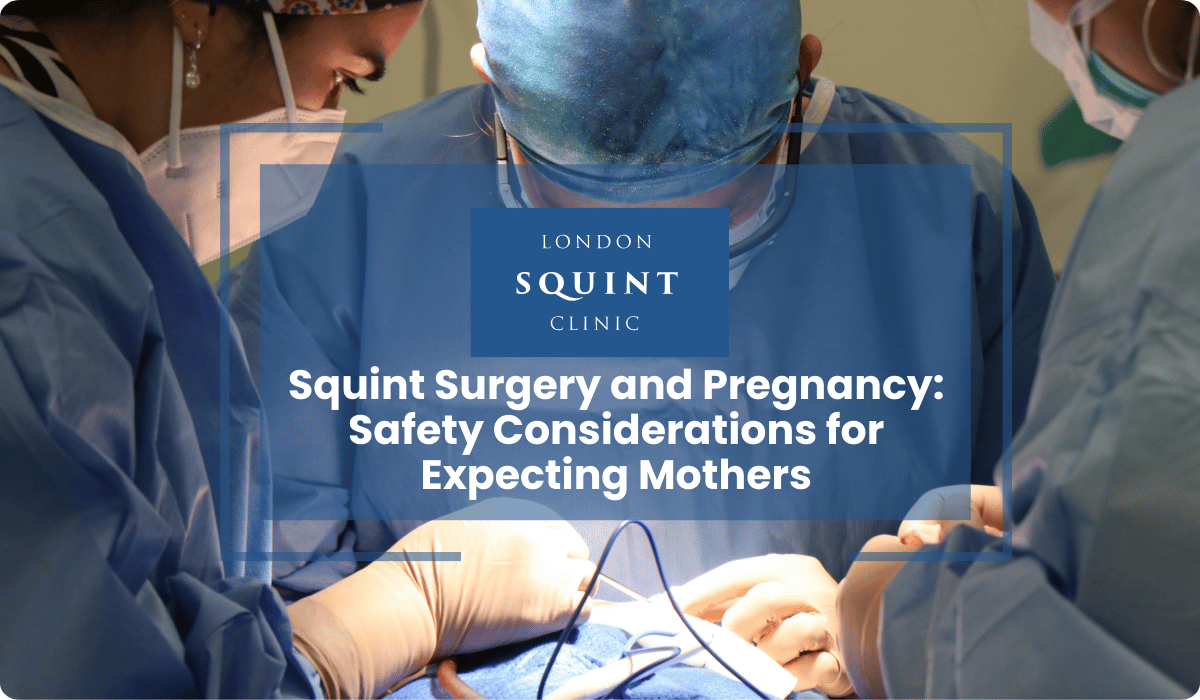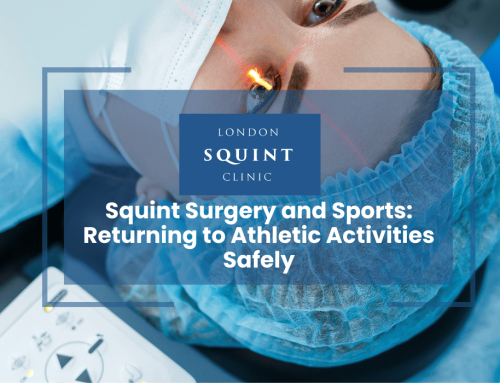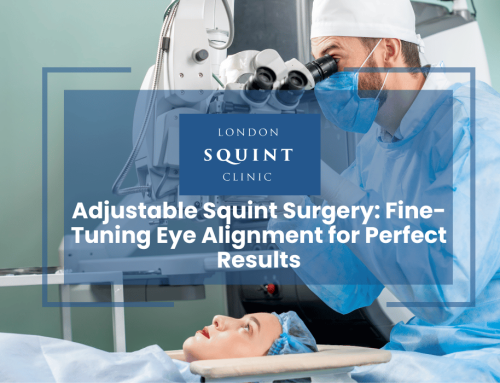Squint Surgery and Pregnancy: Safety Considerations for Expecting Mothers
Managing Squint During Pregnancy
- Pregnancy can affect eye alignment – Hormonal changes may exacerbate existing squints or trigger new ones in up to 15% of pregnant women
- Elective squint surgery is typically postponed – Non-emergency procedures are generally deferred until after delivery to minimize risks to mother and baby
- Non-surgical options are preferred – Prism glasses, occlusion therapy, and orthoptic exercises offer effective symptom management during pregnancy
- Post-delivery waiting period recommended – Allow 3-6 months after childbirth for hormone levels to stabilize before considering surgery, as some pregnancy-induced squints resolve naturally
- Multidisciplinary care is essential – Coordinated assessment by squint specialists, obstetricians, and anesthetists ensures comprehensive care that prioritizes both vision and pregnancy health
Medical Advisory
2023
Table of Contents
- Understanding Squint Conditions During Pregnancy
- How Hormonal Changes Affect Eye Alignment in Pregnancy
- Is Squint Surgery Safe During Pregnancy?
- Anaesthesia Concerns for Pregnant Women Needing Eye Surgery
- When to Consider Postponing Squint Surgery Until After Delivery
- Non-Surgical Alternatives for Managing Squint During Pregnancy
- Post-Pregnancy Timeline for Safe Squint Correction
- Consulting with Specialists: The Multidisciplinary Approach
Understanding Squint Conditions During Pregnancy
Pregnancy is a time of significant physiological changes that can affect virtually every system in the body, including vision. A squint (strabismus) is a condition where the eyes do not align properly, with one eye turning inward, outward, upward, or downward while the other focuses straight ahead. For women who already have a squint, pregnancy can sometimes exacerbate the condition. More surprisingly, some women may develop a new-onset squint during pregnancy.
The prevalence of vision changes during pregnancy is notable, with up to 15% of pregnant women experiencing some form of visual disturbance. While most changes are temporary and resolve after delivery, understanding the relationship between pregnancy and squint conditions is crucial for appropriate management.
Squints during pregnancy may present as intermittent or constant, and symptoms can include double vision (diplopia), eye strain, headaches, and difficulty with depth perception. These symptoms can be particularly challenging during a time when a woman’s body is already undergoing numerous changes and adaptations.
It’s important to distinguish between a pre-existing squint that worsens during pregnancy and new-onset strabismus, as the underlying causes and management approaches may differ significantly. At London Squint Clinic, we provide comprehensive assessments to determine the nature and cause of squint conditions in expectant mothers.
How Hormonal Changes Affect Eye Alignment in Pregnancy
The dramatic hormonal fluctuations during pregnancy can have profound effects on eye health and alignment. Oestrogen, progesterone, and relaxin levels increase significantly, affecting not just reproductive organs but also ocular tissues and visual function. These hormonal changes can influence eye alignment in several ways:
Firstly, increased levels of relaxin—a hormone that loosens ligaments and joints in preparation for childbirth—may affect the extraocular muscles and their supporting structures. This can potentially alter eye alignment in women with pre-existing muscle imbalances or reveal previously compensated squints.
Secondly, fluid retention during pregnancy can affect the orbital tissues surrounding the eyes, potentially changing the mechanical forces acting on the eyeballs. This fluid retention may contribute to changes in eye position and alignment, particularly in women with thyroid-associated eye disease.
Additionally, pregnancy-induced hypertension or pre-eclampsia can affect blood vessels in the eyes and brain, occasionally leading to neurological changes that may manifest as temporary strabismus. In rare cases, hormonal changes can unmask or exacerbate underlying neurological conditions that affect eye movement control.
Research has shown that women with a history of intermittent squint may experience more frequent episodes during pregnancy due to these hormonal influences. Understanding these physiological mechanisms is essential for distinguishing between benign pregnancy-related changes and more serious conditions requiring intervention. At London Squint Clinic, we carefully evaluate these factors when assessing pregnant women with new or worsening squint conditions.
Is Squint Surgery Safe During Pregnancy?
The question of whether squint surgery is safe during pregnancy requires careful consideration of multiple factors. Generally, elective surgical procedures, including squint surgery, are postponed until after delivery whenever possible. This approach minimises potential risks to both mother and foetus.
The primary concerns regarding squint surgery during pregnancy include:
- Anaesthetic risks to the developing foetus, particularly during the first trimester when organ development is most vulnerable
- Physiological stress of surgery on the maternal body, which may affect placental blood flow
- Potential need for medications during and after surgery that may cross the placental barrier
- The possibility that pregnancy-induced squint may resolve naturally after delivery, making surgery unnecessary
- Altered tissue healing responses due to pregnancy hormones, which could affect surgical outcomes
Current medical consensus suggests that non-emergency eye surgeries, including squint correction, should be deferred until after pregnancy. However, in rare cases where severe diplopia (double vision) significantly impacts a pregnant woman’s quality of life or safety, a careful risk-benefit analysis must be conducted.
If surgery is deemed necessary during pregnancy, the second trimester (weeks 14-28) is generally considered the safest period, as organogenesis is complete and the risk of preterm labour is lower than in the third trimester. Each case requires individualised assessment by both ophthalmological and obstetric specialists to determine the optimal approach.
Anaesthesia Concerns for Pregnant Women Needing Eye Surgery
Anaesthesia administration during pregnancy presents unique challenges that must be carefully considered when contemplating squint surgery for expectant mothers. The primary concern is the potential impact of anaesthetic agents on foetal development and maternal physiology.
Local anaesthesia, when feasible for squint procedures, generally poses minimal risk to the foetus as the systemic absorption is limited. However, even with local anaesthesia, sedatives are often used to ensure patient comfort, and these medications can cross the placental barrier. The effects of these agents on foetal development, particularly during the first trimester, remain a significant concern.
General anaesthesia carries additional considerations. While modern anaesthetic techniques have improved safety profiles, there remains a theoretical risk of decreased uterine blood flow during general anaesthesia, potentially affecting foetal oxygenation. Additionally, intubation for general anaesthesia may be more challenging in pregnant women due to airway changes and increased risk of aspiration.
The timing of anaesthesia administration during pregnancy is crucial. The first trimester is generally avoided due to the critical period of organ development. If anaesthesia is absolutely necessary, the second trimester is typically preferred, as organogenesis is complete and the risk of preterm labour is lower than in the third trimester.
At London Squint Clinic, we work closely with obstetric anaesthetists who specialise in managing pregnant patients requiring surgical procedures. This collaborative approach ensures that if surgery is deemed necessary during pregnancy, the anaesthetic plan is tailored to minimise risks while providing adequate surgical conditions.
When to Consider Postponing Squint Surgery Until After Delivery
In most cases, postponing squint surgery until after delivery is the recommended approach for pregnant women. Several specific scenarios warrant particular consideration for deferring surgical intervention:
Firstly, if the squint condition developed during pregnancy with no prior history, there’s a significant possibility that it may resolve spontaneously after delivery as hormone levels normalise. In such cases, waiting to see if natural resolution occurs is prudent before considering surgical intervention.
Secondly, if the squint is causing double vision but can be adequately managed with temporary measures such as prism glasses or occlusion therapy, postponing surgery is advisable. These conservative approaches can provide symptomatic relief without the risks associated with surgery during pregnancy.
Thirdly, women in their third trimester should generally avoid elective surgery due to the increased risk of preterm labour and the logistical challenges of surgical positioning as the pregnancy advances. The physical discomfort of lying flat for extended periods can be significant for women in late pregnancy.
Additionally, if the squint is longstanding and stable, with minimal functional impact on daily activities, there is little justification for undertaking surgery during pregnancy. The potential risks outweigh the benefits in such scenarios.
Finally, women with pregnancy-related health complications such as gestational diabetes, pre-eclampsia, or placental issues should prioritise managing these conditions and defer elective eye surgery until after delivery. The maternal and foetal wellbeing must always take precedence over elective procedures.
Non-Surgical Alternatives for Managing Squint During Pregnancy
For pregnant women experiencing squint conditions, several non-surgical management options can effectively address symptoms while avoiding the risks associated with surgery. These conservative approaches are particularly valuable during pregnancy when elective surgery is generally postponed.
Prism glasses represent one of the most effective non-surgical interventions for managing diplopia (double vision) resulting from squint. These specially designed lenses incorporate prisms that bend light entering the eye, realigning images to eliminate double vision. Prism glasses can be particularly beneficial during pregnancy as they provide immediate symptomatic relief without any invasive procedures.
Occlusion therapy, involving the temporary covering of one eye with a patch or frosted lens, can effectively eliminate double vision in cases where prism correction is not suitable. While not addressing the underlying misalignment, this approach can provide functional relief during the pregnancy period.
Orthoptic exercises, prescribed by specialist orthoptists, may help strengthen eye muscles and improve control in certain types of squint. These exercises can be particularly useful for intermittent squints exacerbated by pregnancy hormones. Regular assessment is essential to monitor effectiveness and adjust the exercise regimen as needed.
For women experiencing eye strain or fatigue associated with their squint condition, simple lifestyle modifications can provide relief. These include taking regular breaks from near work, adjusting screen positions, optimising lighting conditions, and ensuring adequate rest. These measures can significantly reduce symptoms without medical intervention.
In cases where squint is associated with pregnancy-induced hypertension or pre-eclampsia, the primary focus should be on managing the underlying condition through appropriate obstetric care. Addressing these systemic issues may indirectly improve ocular symptoms.
Post-Pregnancy Timeline for Safe Squint Correction
Following childbirth, a woman’s body undergoes significant readjustment as hormone levels normalise and physiological changes of pregnancy resolve. This post-pregnancy period requires careful consideration when planning squint surgery to ensure optimal outcomes and safety.
For squints that developed during pregnancy, specialists typically recommend a waiting period of at least 3-6 months after delivery before considering surgical intervention. This allows time for potential spontaneous resolution as hormone levels stabilise. Many pregnancy-induced visual changes, including some cases of strabismus, may improve naturally during this period without requiring surgical correction.
For women who are breastfeeding, additional considerations apply. While squint surgery itself is generally compatible with breastfeeding, certain medications used during and after surgery may pass into breast milk. The timing of surgery may need to accommodate feeding schedules, and in some cases, temporary interruption of breastfeeding might be recommended depending on the medications required.
The physical recovery from childbirth also influences the timing of elective eye surgery. Women who have undergone caesarean delivery typically need additional recovery time before undergoing another surgical procedure. General anaesthesia, if required for squint surgery, is usually considered safe once the mother has fully recovered from childbirth, typically after 6-8 weeks.
Practical considerations also play a role in timing decisions. Caring for a newborn is physically and emotionally demanding, and the recovery period after squint surgery, though relatively brief, requires rest and limited activity. Many new mothers find it beneficial to establish a routine with their baby and secure adequate support before undergoing elective surgery.
Consulting with Specialists: The Multidisciplinary Approach
Managing squint conditions during pregnancy requires a coordinated effort between multiple healthcare specialists to ensure the best outcomes for both mother and baby. This multidisciplinary approach is essential for comprehensive care that addresses all aspects of the condition within the context of pregnancy.
The ophthalmologist specialising in strabismus (squint surgeon) plays a central role in diagnosing the specific type of squint, assessing its severity, and recommending appropriate management strategies. At London Squint Clinic, our specialists have extensive experience in evaluating squint conditions in pregnant women, recognising the unique considerations this patient group requires.
Obstetricians provide crucial input regarding the stage of pregnancy, any pregnancy-related complications, and the potential impact of eye symptoms or treatments on maternal and foetal wellbeing. Their expertise helps determine the safety and timing of various interventions, particularly if surgery is being considered.
Orthoptists specialise in non-surgical management of eye movement disorders and can provide valuable input on conservative treatments such as exercises, prisms, or occlusion therapy. Their role is particularly important during pregnancy when non-surgical approaches are preferred.
If surgery is deemed necessary, anaesthetists with expertise in obstetric anaesthesia should be consulted to develop a safe anaesthetic plan that minimises risks to both mother and foetus. Their specialised knowledge is invaluable in navigating the complexities of anaesthesia during pregnancy.
In cases where squint may be related to underlying neurological or endocrine conditions, neurologists or endocrinologists may need to be involved in the care team. This is particularly relevant for new-onset squint during pregnancy, which occasionally signals underlying health issues requiring investigation.
This collaborative approach ensures that all aspects of care are considered, from the specific eye condition to the broader context of pregnancy, resulting in management plans that prioritise safety while effectively addressing visual symptoms.
Frequently Asked Questions
Can pregnancy cause a squint to develop?
Yes, pregnancy can trigger new-onset squint (strabismus) in some women. The hormonal fluctuations during pregnancy, particularly increased levels of relaxin, oestrogen, and progesterone, can affect the extraocular muscles and their supporting structures. Additionally, pregnancy-related fluid retention and changes in blood pressure can impact eye alignment. Approximately 15% of pregnant women experience some form of visual disturbance, with new or worsening squint being one possible manifestation.
Will a pregnancy-induced squint resolve after delivery?
Many cases of pregnancy-induced squint resolve spontaneously within 3-6 months after delivery as hormone levels normalize. This is particularly true for squints that developed for the first time during pregnancy with no prior history. However, resolution isn’t guaranteed in all cases, which is why specialists typically recommend waiting several months postpartum before considering surgical intervention to allow time for potential natural improvement.
What are the safest treatments for squint during pregnancy?
The safest treatments for squint during pregnancy are non-surgical approaches, including:
– Prism glasses to correct double vision
– Temporary occlusion therapy (patching one eye)
– Orthoptic exercises prescribed by eye specialists
– Lifestyle modifications to reduce eye strain
– Regular monitoring by an ophthalmologist
These conservative measures avoid the risks associated with surgery and anesthesia while effectively managing symptoms until after delivery.
If I need squint surgery, how long after giving birth should I wait?
Most specialists recommend waiting at least 3-6 months after delivery before undergoing squint surgery. This waiting period allows for:
– Potential spontaneous resolution of pregnancy-induced squint
– Normalization of hormone levels that may affect surgical outcomes
– Physical recovery from childbirth, especially after cesarean delivery
– Establishment of breastfeeding routines if applicable
– Arranging adequate support for childcare during the recovery period
The exact timing should be determined in consultation with both your ophthalmologist and obstetrician.
Can I use eye drops for squint-related symptoms during pregnancy?
The safety of eye drops during pregnancy depends on the specific medication. Some eye drops used for diagnostic purposes or symptom management may be considered safe, while others contain ingredients that could potentially cross the placental barrier. Always consult with your ophthalmologist and obstetrician before using any eye medication during pregnancy. When necessary, they can recommend the safest options with the lowest potential risk to the developing fetus.
How does breastfeeding affect the timing of squint surgery?
Breastfeeding itself doesn’t contraindicate squint surgery, but it requires special considerations. Some medications used during and after surgery may pass into breast milk in small amounts. Your surgeon may recommend scheduling surgery to allow for pumping and storing breast milk beforehand, temporarily interrupting breastfeeding, or selecting alternative medications that are more compatible with breastfeeding. Discuss your breastfeeding plans with your surgical team to develop an appropriate management strategy.
What warning signs indicate I should seek immediate care for eye problems during pregnancy?
Seek immediate medical attention if you experience:
– Sudden onset of double vision or squint
– Vision loss or significant vision changes
– Severe eye pain
– Flashing lights or numerous new floaters
– Visual field defects (blind spots)
– Eye symptoms accompanied by severe headache, abdominal pain, or high blood pressure
These symptoms could indicate serious conditions requiring urgent assessment, including pre-eclampsia, which can have ocular manifestations during pregnancy.
Find out if you are suitable for Double Vision Treatment
Not everyone is eligible for double vision surgery.
Find out if you could benefit from this life-changing surgery by taking the quick self-suitability quiz below:
Our most popular procedures

Hello, I’m Nadeem Ali
I’m one of the few eye surgeons in the world with 100% focus on Squint and Double Vision Surgery.
I have 24 years of eye surgery experience, and worked for 13 years as a Consultant at London’s renowned Moorfields Eye Hospital.
In 2023, I left the NHS to focus fully on treating patients from across the world at the London Squint Clinic. You can read more about me here.
There’s lots of information on the website about: squint surgery, double vision surgery and our pricing.
The most rewarding part of my job is hearing patients tell me how squint or double vision surgery has changed their lives. You can hear these stories here.
Mr Nadeem Ali
MA MB BChir MRCOphth FRCSEd(Ophth)





